|
|
|
Sort Order |
|
|
|
Items / Page
|
|
|
|
|
|
|
| Srl | Item |
| 1 |
ID:
148916
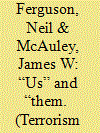

|
|
|
|
|
| Summary/Abstract |
This article draws on data from one-to-one interviews with members and former members of the Ulster Volunteer Force, Ulster Defence Association, Red Hand Commando, Ulster Political Research Group, and the Progressive Unionist Party to explore the dynamic and fluid perceptions of the Irish Republican Army (IRA) and Sinn Féin among Ulster loyalists. The article will explore how attitudes and perceptions are influenced by the shifting political landscape in Northern Ireland as Ulster loyalists come to terms with the new realities created by the peace process, security normalization, decommissioning, and the rise in the threat of dissident republican violence. The article will also demonstrate that these perceptions are not purely antagonistic and based on the creation of negative, stereotypical “enemy images” fuelled by decades of conflict, but pragmatic, bound to societal and local events, and influenced by intragroup attitudes and divisions, in addition to the expected conflictual ingroup vs. outgroup relationships. Finally, the article will explore how loyalists employ republicanism and the transformation of the Provisional IRA in particular, as a mirror or benchmark to reflect on their own progress since 1994.
|
|
|
|
|
|
|
|
|
|
|
|
|
|
|
|
| 2 |
ID:
133544
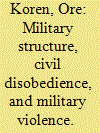

|
|
|
|
|
| Publication |
2014.
|
| Summary/Abstract |
In this article, I argue that factors inherent to the structure of a military organization and their relationship with the political leadership play a role in the organization's tendency to perpetrate violence against civilians during civil disobedience campaigns. To examine this hypothesis, I conducted a three-phased statistical analysis on a database containing 97 campaigns that took place between 1972 and 2012. In the first phase, I examined the relationship between military centric factors and violent crackdowns. In the second phase, I examined the relationship between military centric factors and mass killing. In the third stage, I examined the relationship between two specific types of discrimination in the military and mass killing. I found strong evidence supporting the hypothesis mentioned above. High-risk militaries that served a militarized regime, contained loosely regulated or indoctrinated paramilitaries, and discriminated against the protesting group, were much more likely to perpetrate violence against civilians during civil disobedience campaigns than low-risk militaries. The conclusions of this study suggest that further examination of the military's role in perpetrating violence against civilians during protests and conflict may provide some novel findings.
|
|
|
|
|
|
|
|
|
|
|
|
|
|
|
|
| 3 |
ID:
141179
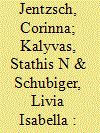

|
|
|
|
|
| Summary/Abstract |
Militias are an empirical phenomenon that has been overlooked by current research on civil war. Yet, it is a phenomenon that is crucial for understanding political violence, civil war, post-conflict politics, and authoritarianism. Militias or paramilitaries are armed groups that operate alongside regular security forces or work independently of the state to shield the local population from insurgents. We review existing uses of the term, explore the range of empirical manifestations of militias, and highlight recent findings, including those supplied by the articles in this special issue. We focus on areas where the recognition of the importance of militias challenges and complements current theories of civil war. We conclude by introducing a research agenda advocating the integrated study of militias and rebel groups.
|
|
|
|
|
|
|
|
|
|
|
|
|
|
|
|
| 4 |
ID:
163705
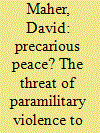

|
|
|
|
|
| Summary/Abstract |
This article provides an investigation into claims that paramilitary violence in Colombia can pose a threat to the peace agreement signed in 2016 between the Colombian government and the FARC rebels. These claims highlight the capacity for paramilitary groups to ‘spoil’ the peace deal. Hitherto, however, there is a lack of scholarly research to investigate the potential of paramilitary spoiling. Firstly, this article highlights the flaws in the government’s perspective that paramilitarism no longer exists in Colombia. Instead, the government argues that Colombia is plagued by criminal bands (known as BACRIMs). Secondly, through fieldwork interviews and questionnaires conducted in FARC demobilisation camps, together with descriptive data analysed through a uniquely coded dataset on violence in western Colombia, this article supports claims that successor paramilitary groups represent a key spoiler threat to the current government-FARC peace process. On the one hand, the paramilitaries can represent a direct spoiler threat by, for instance, violently targeting demobilising FARC guerrillas. On the other hand, successor paramilitary groups represent a key indirect spoiler threat, as paramilitary violence is exacerbating the root causes of the conflict that the peace deal seeks to address, with negative implications for the prospects for peace.
|
|
|
|
|
|
|
|
|
|
|
|
|
|
|
|
| 5 |
ID:
119958


|
|
|
|
|
| Publication |
2013.
|
| Summary/Abstract |
This article counterclaims that ideology lacks relevance to contemporary armed conflicts, especially when economic factors play an important role. Focusing on the case of Colombia, the authors utilize logistic regression analysis to test whether ideology allows one to distinguish between different armed groups and whether a combatant's level of agreement with his or her armed group is related to affinity for that group's ideology. The high degree of collinearity between three indicators of ideology-discourse, attitudes, and emotional responses-and their similar explanatory power support the article's conceptual proposal of viewing them as different dimensions of the same phenomenon. The authors find that ideology continues to play a role in the internal dynamics of Colombian armed groups and that a combatant's ideological development is influenced not only by pre-enlistment experiences but also by participation in a particular group. Future research should not ignore ideology as an important element of contemporary armed conflicts.
|
|
|
|
|
|
|
|
|
|
|
|
|
|
|
|
| 6 |
ID:
132172
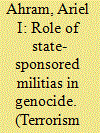

|
|
|
|
|
| Publication |
2014.
|
| Summary/Abstract |
This article explains how and why armed, non-state actors collaborate with states to inflict massive levels of violence. Regime type and state capacity interact to provide state elites a menu of repertoires for implementing violence, some emphasizing direct state action, others emphasizing cooperation and alliance between state and armed, non-state actors. Rather than struggling in vain to build strong states to eliminate armed non-state actors and establish a monopoly over the use of force, averting genocide might necessitate recruiting and strengthening the power of indigenous, armed non-state actors.
|
|
|
|
|
|
|
|
|
|
|
|
|
|
|
|
| 7 |
ID:
164914


|
|
|
|
|
| Summary/Abstract |
This article sets out to explain how the Sadrist movement targeted ex-combatant communities in their communication strategy to mobilize the Mahdi Army. The Mahdi Army was established by the Sadrist movement under the guidance of Muqtada al-Sadr in 2003. This article proposes that post-2003 Iraq experienced a demobilisation crisis, fostering segments of ex-combatant communities whose ingrained repertoires were prone to paramilitarisation. Contrary to many other paramilitary organisations around the world, the Mahdi Army was formalized through a bottom-up process by non-state actors, and only at a later stage was the Mahdi Army explicitly co-opted by the Iraqi state in 2005. The overarching argument of this article is that social networks with specific assets, skills and history are more vulnerable to paramilitarisation by entrepreneurs of violence than various other networks.
|
|
|
|
|
|
|
|
|
|
|
|
|
|
|
|
| 8 |
ID:
087356


|
|
|
|
|
| Publication |
2009.
|
| Summary/Abstract |
This article uses the analytical model put forward by Kalyvas in his Logic of Violence in Civil War to explore the violent transition experienced by Barrancabermeja from 1998 onwards, when the increasing insurgent presence was curbed by paramilitary groups and government forces. While the model sheds light on the causal mechanisms that led to violence against civilians, it fails to predict some of the observed outcomes; these anomalies are discussed with a view to expanding its explanatory power. Furthermore, the paper highlights the relevance of socioeconomic factors and spatial segregation in predicting the distribution of violence.
|
|
|
|
|
|
|
|
|
|
|
|
|
|
|
|
|
|
|
|
|